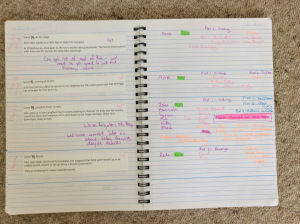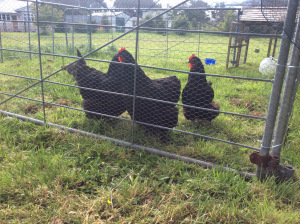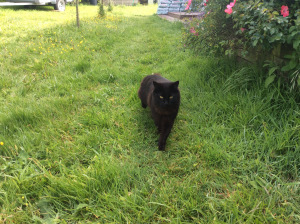Jude Knight's Blog, page 160
November 12, 2014
To thine own story be true…
 Indie Plot Twist has a guest post from my Twitter friend Danielle Hanna: Making a list and checking it twice.
Indie Plot Twist has a guest post from my Twitter friend Danielle Hanna: Making a list and checking it twice.
It’s all about using list making and then a bit of careful analysis to decide what happens next.
Great ideas, and written with Danielle’s typical humour and light touch. Enjoy!



November 11, 2014
Write with style
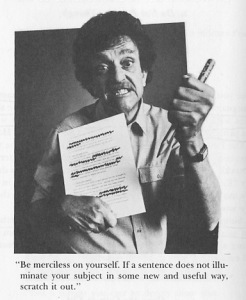 A grateful curtsey (in place of an anachronistic tip of the hat, or H/T) to the person who tweeted a link to the Brain Pickings article about Kurt Vonnegut’s 8 keys to power of the written word.
A grateful curtsey (in place of an anachronistic tip of the hat, or H/T) to the person who tweeted a link to the Brain Pickings article about Kurt Vonnegut’s 8 keys to power of the written word.
Here’s his list. Click on the link to find out what Vonnegut has to say about each one.
Find a subject you care about
Do not ramble, though
Keep it simple
Have the guts to cut
Sound like yourself
Say what you mean to say
Pity the readers
For really detailed advice…



November 10, 2014
Some like it hot
 I’ve been mulling over heat-level descriptions in romance novels. According to a discussion I’ve been in on Goodreads, readers hate finding themselves in a novel that gives them more or less sex than they expected. (Both seem to rub people up the wrong way.)
I’ve been mulling over heat-level descriptions in romance novels. According to a discussion I’ve been in on Goodreads, readers hate finding themselves in a novel that gives them more or less sex than they expected. (Both seem to rub people up the wrong way.)
My hero and heroine in Farewell to Kindness have (I hope, or I’ve done it wrong) quite a bit of heat between them. They kiss several times, they have one memorable night, they think about one another a lot, and Rede’s thoughts are definitely carnal (what can I say; he’s a 34-year-old male who has been celibate since his wife died 3 years ago).
And my villainess is either having sex or thinking about it in most, if not all, of her scenes.
So the heat-rating ‘sweet sensuality’ doesn’t fit. And I’ve gone beyond ‘mild’ in a couple of places, too.
On the other hand, the heat-rating ‘hot sensuality’ seems over the top. The passionate encounters take up a tiny fragment of the whole, and I tend to use non-specific language and focus on emotions rather than physical descriptions (with a few notable exceptions).
As I’ve noted elsewhere, even this level of heat was enough to make me change my heroine’s name.
The villainess Lydia’s scenes are left largely to the imagination of the reader. Here’s the start of the scene where I introduce her:
The boy was enthusiastic, but unskilled and undisciplined. He grunted and heaved over Lydia, striving for his own completion without regard to hers. He would improve with a little tutoring, however. Yes, she would certainly teach him how to give pleasure. While that was by no means her reason for taking him as her lover, she saw no reason to deny herself the benefits of his teenage vigour.
A movement caught her eye. The boy was too far gone to notice Baron Carrington, lounging at his ease in the doorway.
She raised one eyebrow. She hated, feared, and loved her husband in equal measure, and knew better than to show any of those emotions.
He smiled coldly, then gestured with his head. She had no difficulty interpreting the command. “Come and see me when you have finished.” He didn’t wait to see her acknowledgement, fading from the doorway as silently as he had appeared.
The boy stiffened all over, letting out a shout as he reached his climax. She let out her own cry. Letting him think he’d pleased her would help to bind him to her. Bindings. There was a thought worth exploring. If she bound him to the bed, she could force him to slow down.
Later. For now, the Baron waited. And the Baron did not like to wait.
Not hot. Right? But certainly not sweet. Okay, she’s the villainess, so here’s a bit starring Rede and Anne. They’ve spent the night in a cottage, sharing the one bed, but she was asleep before he got into it:
Anne woke in the pre-dawn light, aware of a warm large presence enfolding her in the bed. Rede was wrapped around her, his front spooned against her back, one large arm flung over her body, and one leg over her hips.
She lay still, cataloguing each of the touch points. Rede’s hand brushed her breast. His leg hooked back to rest against the front of her thighs. Against her buttocks, something hard pressed. Was that what she thought? If so, it seemed bigger than she expected.
She resisted the urge to squirm against it. Instead, she lifted Rede’s arm, and carefully pushed it behind her. As it fell back against his side, he rolled onto his back, freeing her from the cage of his body.
She lay still for a few moments more, waiting to see if he woke, but his breathing didn’t change.
After a while, she wriggled a bit further away, so that she could sit up without disturbing him. He lay beside her, flat on his back, still sleeping. He had rolled from under the covers, which were all bunched up on her side of the bed.
She was a little disappointed to see that he’d come to bed in shirt and pantaloons. But his shirt was unbuttoned, and she could see a vee of his chest, with a dusting of golden hair. And she could see his feet. She had never before thought of feet as beautiful, but his were. Narrow and straight, with long elegant toes to go with the long elegant fingers that had cared for her so tenderly last night.
“My darling,” he had said. How she wished she really was.
She continued her examination. The strong curves of his chest, the flat planes of his abdomen. And, yes, there. Where the pantaloons were tented over… she had no idea what to call it. The male part of him.
Without thinking, she reached out a hand, stopping a few inches in the air above the stretched fabric.
“You can touch it if you wish,” Rede said.
She snatched her hand back and looked at him, feeling the heat as she blushed.
He hadn’t moved, except to open those blue, blue eyes.
So I’m calling the novel warm, following Tori Macallister, who did a lovely post on the various rating systems people use.



November 9, 2014
A necessary sacrifice
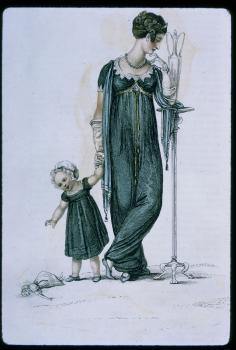 On the train today, I decided to kill one of my favourite characters. I’m sad, but I’m convinced it’s the right thing to do.
On the train today, I decided to kill one of my favourite characters. I’m sad, but I’m convinced it’s the right thing to do.
I completed the third draft edit on page 135 of 506 pages, so he has around 340 more pages to live. At the current rate, he’ll be dead by next weekend.
I’ve lost over 2000 words in the edit so far, but it’s still a bit of an epic (127,000).



November 8, 2014
#amediting part 2
I’ve always agreed with the aphorism that good books are not written, they’re rewritten. All power to the elbows of those who can write once and publish. I’m not one of those writers. So how am I editing?
First I went through the draft as I did it, each day checking what I wrote the day before.
Then, after attending the Romance Writers of New Zealand conference in September, I completely rewrote the 30,000 words I had up to that point.
Then, as I came up with new ideas, I went back and planted seeds in earlier chapters.
So by the time I finished Farewell to Kindness, I was calling what I had the second draft.
As I approached the end of the writing, I read up on editing, and I posted what I found.
Next, I worked out my own process, which was a kind of an amalgam of everyone else’s with a few of my own ideas thrown in.
I took a long weekend, and – in a marathon 35-40 hour sprint – went through the whole book in hardcopy, page by page, writing character names, plotpoints, story outline, and any ideas or discrepancies in a spiral-bound notebook.
Then I decided that I needed to put some of this into a spreadsheet.
So I’ve spent every evening for the last week (and a few midnight hours) creating a three-tab spreadsheet. Tab one has all the plots across the top (four strands to the major plot, and 16 subplots), and all the scenes down the left hand side. I’ve marked where plots start, where they end, and where I’ve got lost somewhere in the middle.
This let me work out that I need to drop a couple of the minor plots because they aren’t needed, I need to work in a bit more about the Revenge strand of the major plot, because I pretty much forget about it in the middle of the book, and I need to close off some minor plots that I left hanging.
On tab two, I’ve listed all the characters in each scene. I’ve found (and fixed) some name changes by doing this. I’ve also put descriptions of characters when they appear in the book, so I could check that I didn’t change a person’s eye colour, height, or other personal characteristics.
Tab three is a calendar. I’ve added the phases of the moon, and moonset, moonrise, sunset and sunrise where they’re significant to the plot, and I’ve put the scenes in day by day. This allowed me to find out that Rede had an extra day up his sleeve, and could have been back in time to save Anne, so I’ve worked out something to delay him (which, not just incidentally, also allows me to close off my dangling plot lines before we get to the grand finale).
So here’s the spreadsheet. You’ll see it goes right from the left of my desktop screen to the right of my laptop screen.
It’s been a little tedious, but I’m finding it a remarkably efficient way to work. My mind goes off on flights of fancy while my fingers are filling in character names, and all of a sudden a difficulty resolves itself.
Next step (already started) is to rewrite to bring all the ideas into the third draft. I’m pretty happy with the preface and first three chapters, and I’m excited about the changes and new scenes coming up.
The plan is to get the third draft done then prepare a copy for beta readers within the next fortnight. I’ll let you know how I get on.



November 7, 2014
Spring in the garden is a delight
The Black Evil One and the Henchcat love when I move the hens. They reckon that I just have to slip up and leave the cover off, and they’ll eat like queens for weeks.
I have been neglecting everything else in favour of the novel. The hens were living in a moonscape; the tomatoes need to be tied up; I managed to treat the trees for curly leaf, but thinning the fruit? If the trees want their fruit thinned, they’ll just have to do it themselves.
Today, the plan is to spend the morning catching up on the ever increasing to do list.
I’ve moved the hens, but still have to change the sand in the tray of their roost and put clean straw in their nest boxes.
And then catch the flibberty things to dust them with mite powder.
I’ve tidied up around the house a bit, but the grandkids that are staying with me for the weekend are going to help me wash the windows inside and out.
Tomatoes, I will get to you, promise.
Meanwhile, the PRH is going to mow the lawn (nearly 2 acres of it), but first, he tells me, he needs to cut some fillets so he can stack the wood for my new raised garden beds. Fillets, he says, are bits of scrap wood that go between planks to hold them off one another so the air can circulate to let the timber dry. Who knew?
The title of this piece is the first line from a chapter in Farewell to Kindness. Yes, okay, that’s where my mind is.
Up to page 337 of 506 on the plot line review, and page 97 on the third draft edit. Wait for me, novel. I’m coming!



November 6, 2014
A brief glossary for novice novelists
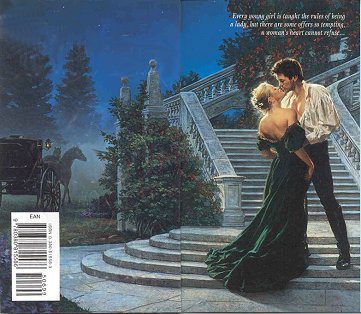 Here are a few of the words I’ve had to look up since I started taking my novel writing seriously. Most of them are not romance-genre specific. All of them were new to me.
Here are a few of the words I’ve had to look up since I started taking my novel writing seriously. Most of them are not romance-genre specific. All of them were new to me.
Beta reader: I’ve been seeking beta readers for Farewell to Kindness, and one of the people I asked said ‘what’s that?’ A beta reader is kindly soul who agrees to read your 3rd, 4th, or 5th draft (the one you think is just about finished) and give you a reader’s honest opinion. A beta reader is not doing a proofread or a copy edit. They’re reacting to the story as a reader would.
Category or series titles: A short romance novel (55,000 words) published within a clearly delineated line with a distinct identity, which may involve similar settings, characters, time periods, levels of sensuality, or types of conflict. Publishers of these lines include Harlequin/Mills & Boon.
Indie publisher: Indie is short for independent – a person who decides to go it alone and self-publish.
Novel: A work of 40,000 words or more
Novella: A work of between 17,500 and 40,000 words
Novelette: A work of between 7,500 and 17,500 words
Pantster: Writers are apparently either planners or pantsters. Planners plot everything in advance. Pantsters write by the seat of their pants, finding out what’s happening as they go along. I do extensive planning in advance, and go into the book with a clear idea about the characters and what is going to happen. Then the story takes over and I shoot off in a completely different direction. I rewrite my plans constantly as I go, each day finishing the day’s work by writing the story line for the next day. Then my characters surprise me again the next day and I have to do it over. Am I a planner or a pantster?
Planner: see pantster
POD: Print on Demand – using digital printing techniques to print copies of a book one at a time, as they are ordered. While not as economical per copy as traditional printing for large print runs, POD makes it possible to provide small numbers of books and save on warehousing space and print overruns.
POV: Point of view – the perspective from which the story is written. In my novel, I’ve used third-person limited, where I’m inside the head of a particular character during a scene, but cannot write about anything that character doesn’t know or sense.
Series: A group of books with connecting themes, characters, or both.
Series titles: see Category or series
Short Story: A work under 7,500 words
Single-title: A romance novel that is not published as part of a category line. They are typically longer than category novels (100,000 to 120,000 words), which means the writer has room to develop subplots and secondary characters.
Step-back: the picture on the inside of the cover – a tradition in romance novels that is making a comeback. The two together are called two-image covers.
If you have more, please add them in the comments. My lunch hour is over, and I’m back to work.
The Slang for Writers I found is more about writing and plot development terms, so not relevant to this post. Good to read, though. Consider it a bonus.



November 5, 2014
Is that a rooster in your pocket… ?
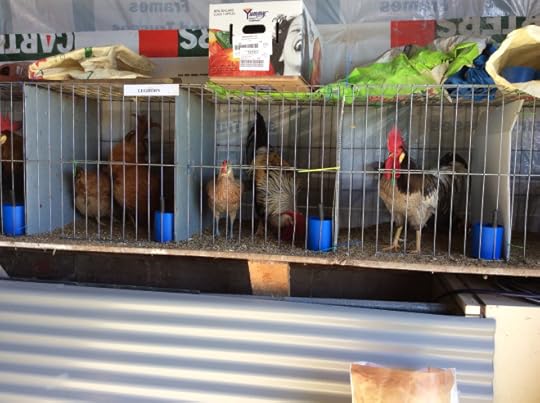
A row of roosters and their hens at the local agricultural show. I think the one on the right is my Mr Peep.
I’ve been researching the c–k term since I mentioned on Facebook that I’d included a joke around it in Farewell to Kindness. (Anne’s sister has a pet rooster which the heroine brings with her to stay at the hero’s house, allowing the heroine’s cousin to make jokes about the hero needing a prize-winning c–k).
One of the commenters said that the term in England was cockerel, and that the term c–k wouldn’t be used.
The same conversation came up on a Goodread’s thread, where another novelist asked about acceptable and time-appropriate terms.
It turns out that the one I wanted to use was in common use for both male birds and male members, and was not considered unfit for polite company (even when referring to male domestic fowl) until Victorian times, about 25 years after the setting for my book.
And a cockerel was, until Victorian times, a young male chicken – under 12 months old. The Victorian English applied the junior bird term to all male chickens of any age, while the Puritan Americans reacted to the double entendre a 150 years earlier, and adopted the term rooster.
So I can keep my joke and remain historically accurate, though Alex’s pun would have had him banned from the dinner table if the more innocent ladies at the table had understood his double meaning.
Other writers have clearly faced the same challenge, and some clever person has responded with a timeline diagram for male anatomy terms, taken from Green’s Dictionary of Slang, by Jonathon Green.
I could go for man Thomas, though there are a number of other possibilities. Calling it a battering piece might break the mood of my love scene, don’t you think? And shaft of delight, while authentic, is rather too congratulatory. Tickle tail is funny, and gay instrument might be misunderstood by today’s readers.
Here, by the way, is the equivalent timeline diagram for female anatomy terms.



November 4, 2014
Procrastibaking
Writing this post is a form of procrastibaking – creating something that I hope will be useful to others, but that doesn’t take me further on the jobs I need to do.
On the novel, I’m up to page 266 (of 506) and scene 53 of the plot-line and character name review, and page 28 (about to start Chapter 3) of the rewrite. Chapter 3 needs to be completely rewritten, and I’m dithering over how to start.
I could also be doing character sketches for the novella I want to bring out before Christmas, Candle’s Christmas Chair. (Seven weeks away. Yikes!) I’m about halfway through getting to know Candle Avery, and I still have to learn about his mother and Minerva Bradshaw, the woman he encounters in a carriage manufactory, making Bath chairs.
And I should be thinking about the next two novels to make sure that nothing I do in Farewell to Kindness stuffs up the plotlines for Encouraging Prudence or A Raging Madness.
On the commercial writing side, I’m working from home today, and am due to start in a few minutes. I finally have the information I need to review five templates, write guidelines for using them, rewrite the relevant style guide, and create a one hour seminar to introduce them all. The seminar is to be delivered in less than four weeks. And I have a 70 page guide for another client to edit by Friday week.
Busy is good. At least that’s what I tell myself.
But I always dither at the start of a project. Intellectually, I know I’ll be fine once I get started. But every time, I circle around the project and find other things to do. I tidy my desk. I make phone calls. I send emails I’ve been meaning to do for a while. I fiddle with the back settings of the blog.
Work is good. Work puts food on the table and a smile on my face.
But for the moment, I’m procastibaking.



November 3, 2014
He was drunk. But not nearly drunk enough.
 I’ve rewritten the first chapter, changed the POV, lost 500 words, and turned it into a prologue.
I’ve rewritten the first chapter, changed the POV, lost 500 words, and turned it into a prologue.
He was drunk. But not nearly drunk enough. He still saw the boy’s dying eyes everywhere. In half-caught glimpses of strangers reflected in windows along Bond Street, under the hats of coachmen that passed him along the silent streets to Bedford Square, in the flickering lamps that shone pallidly against the cold London dawn as he stumbled up the steps to his front door.
They followed his every waking hour: hot, angry, hate-filled eyes that had once been warm with admiration.
He drank to forget, but all he could do was remember.
I’ve posted the whole prologue on my excerpts page. Take a look and see what you think.




